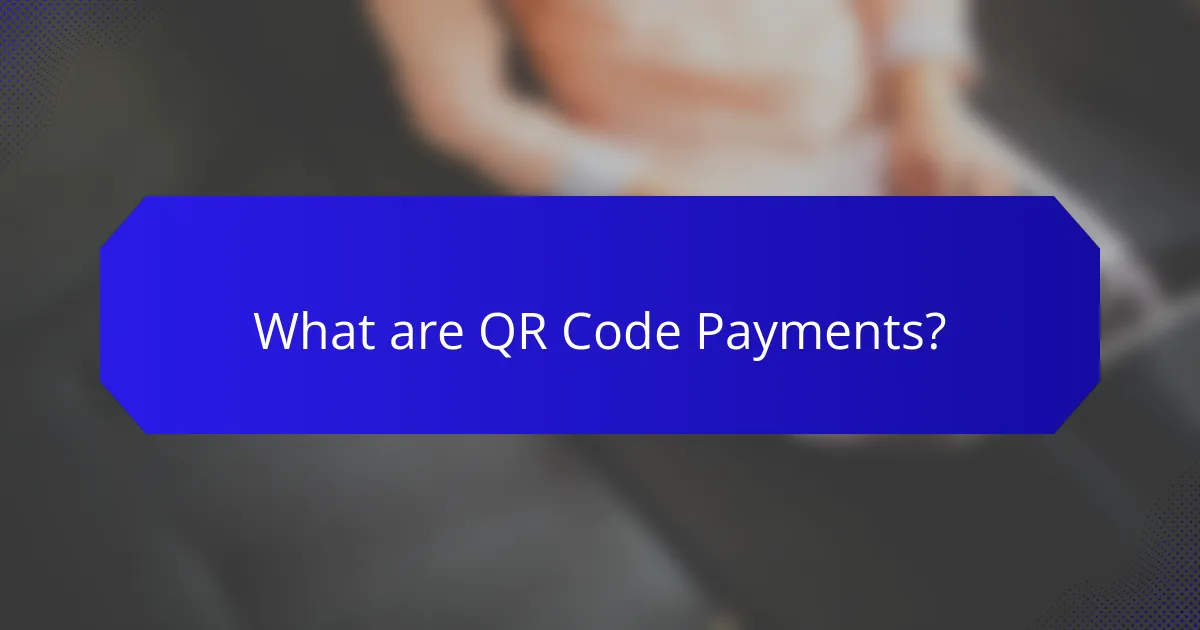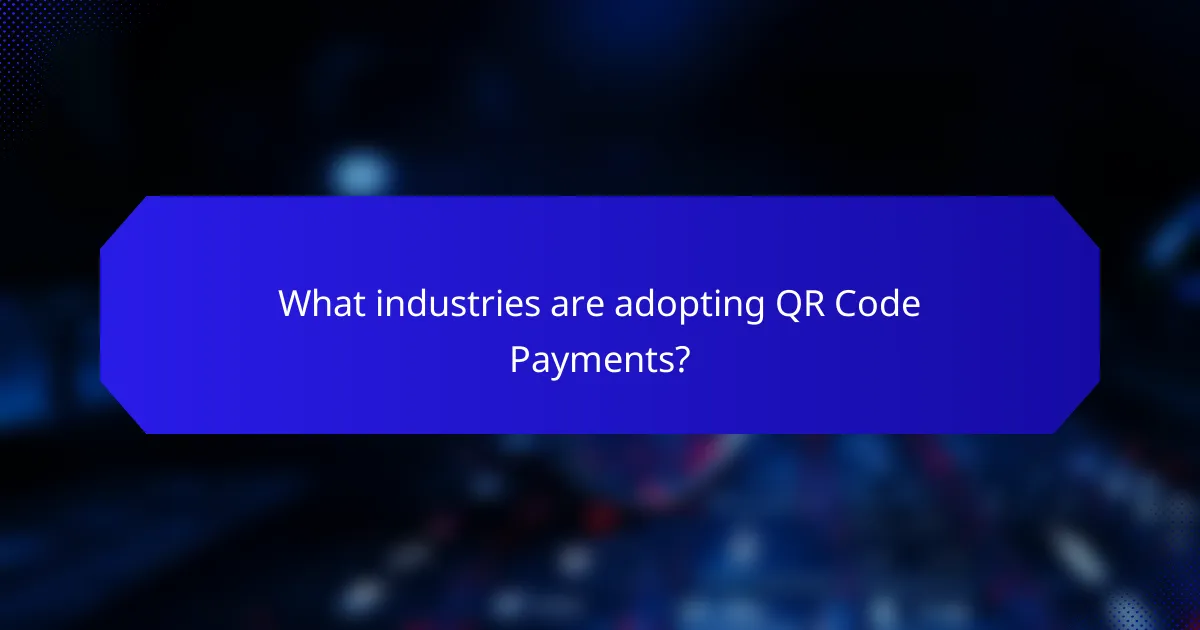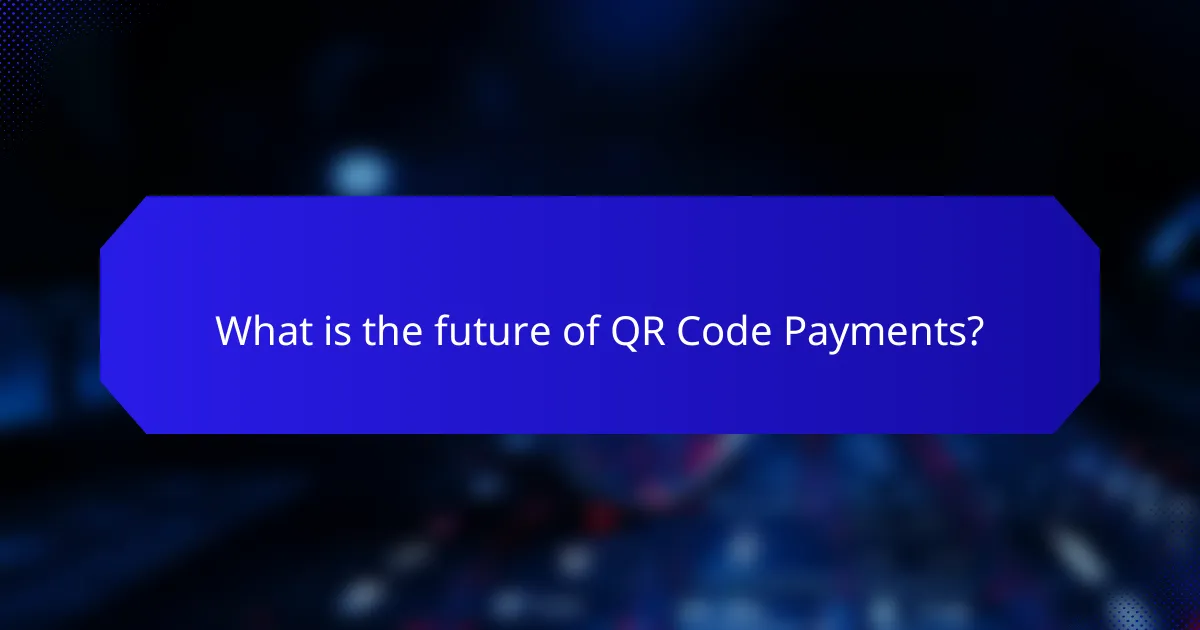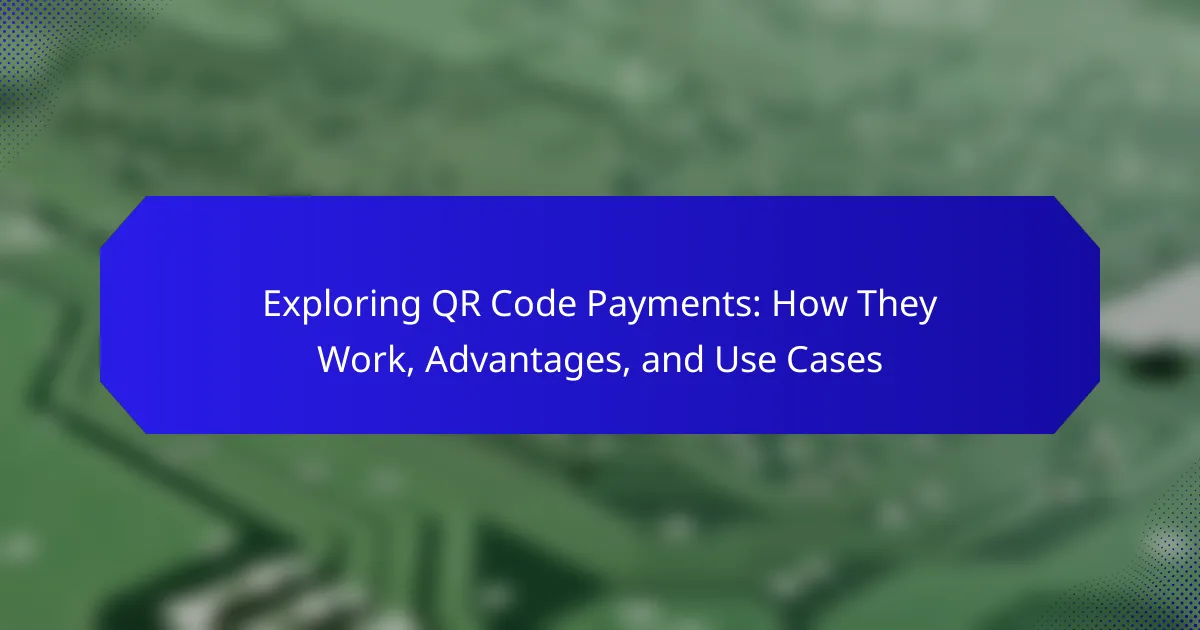QR Code Payments utilize Quick Response (QR) codes to facilitate efficient and contactless transactions. This payment method is increasingly adopted across various sectors, including retail, hospitality, transportation, and e-commerce, allowing users to initiate payments by scanning QR codes with their smartphones. The article explores the mechanics of QR Code Payments, highlighting their advantages such as convenience, speed, and enhanced security features. Additionally, it discusses the growing market for QR code payments, projected trends, and their integration into loyalty programs and marketing strategies, reflecting a significant shift towards mobile payment solutions.

What are QR Code Payments?
QR Code Payments are a method of transaction that utilizes Quick Response (QR) codes for facilitating payments. Users scan a QR code with their smartphone or device to initiate a payment process. This method allows for quick and contactless transactions. QR Code Payments are widely used in retail, restaurants, and online shopping. They enhance convenience by eliminating the need for cash or physical cards. According to a report by Statista, the global QR code payment market is expected to grow significantly, reflecting their increasing adoption. Many businesses prefer QR Code Payments for their simplicity and efficiency.
How do QR Code Payments function?
QR Code payments function by scanning a QR code with a mobile device to initiate a transaction. The QR code contains payment information encoded within it. When scanned, the user’s mobile wallet or payment app retrieves this information. The app then prompts the user to confirm the payment amount. After confirmation, the payment is processed through a secure network. This method allows for quick and contactless transactions. QR Code payments are widely used in retail, dining, and online shopping. They enhance convenience and reduce the need for cash or physical cards.
What technology underpins QR Code Payments?
QR Code payments are underpinned by two primary technologies: QR codes and mobile payment systems. QR codes are two-dimensional barcodes that store information, such as payment details. Mobile payment systems enable users to make transactions via smartphones. These systems often utilize Near Field Communication (NFC) for secure transactions. Additionally, encryption protocols protect sensitive data during the payment process. According to a report by Statista, the global mobile payment market is projected to reach over $12 trillion by 2025. This growth highlights the increasing reliance on QR code technology for secure and efficient transactions.
How are QR Codes generated and scanned?
QR Codes are generated using specific software or online tools that convert data into a matrix barcode format. This process involves inputting the desired information, such as URLs or text, into a QR Code generator. The generator then creates a visual representation of the data in a square format. Scanning QR Codes is accomplished using a camera-equipped device, such as a smartphone. Users open a QR Code scanning application or the device’s camera, which detects the code. The scanned QR Code is then decoded, revealing the embedded information. This method is widely used for payments, marketing, and information sharing.
What are the advantages of using QR Code Payments?
QR Code payments offer several advantages. They provide a fast and convenient payment method. Users can complete transactions quickly by scanning a code with their smartphone. This reduces the time spent at checkout. QR Code payments are also contactless, enhancing safety during transactions. They minimize physical contact, which is crucial in maintaining hygiene. Additionally, QR Codes can be easily generated and shared. Businesses can create them at low costs without needing special hardware. QR Code payments are widely accepted across various industries. According to a report by Statista, the global QR Code payment market is expected to grow significantly, indicating increasing adoption.
How do QR Code Payments enhance transaction speed?
QR Code Payments enhance transaction speed by allowing instant data transfer between the customer and the merchant. The customer scans a QR code using their mobile device. This process eliminates the need for manual entry of payment information. As a result, transactions can be completed in seconds. According to a study by Juniper Research, QR code payments can reduce transaction time by up to 50%. This efficiency is particularly beneficial in high-traffic environments, such as retail stores or restaurants. Faster transactions lead to improved customer satisfaction and increased sales throughput.
What security features do QR Code Payments offer?
QR Code Payments offer several security features to protect transactions. One key feature is encryption, which secures the data transmitted between the user’s device and the payment processor. This helps prevent unauthorized access to sensitive information. Another feature is dynamic QR codes, which change with each transaction, reducing the risk of fraud. Additionally, many QR Code payment systems utilize two-factor authentication, requiring users to verify their identity before completing a transaction. This adds an extra layer of security. Furthermore, transaction monitoring is employed to detect and prevent suspicious activities in real-time. These features collectively enhance the security of QR Code payments, making them a safer payment option.

What industries are adopting QR Code Payments?
Retail, hospitality, and transportation industries are adopting QR code payments. Retailers use QR codes for quick customer transactions. Restaurants enable contactless payments through QR codes on menus. Public transport systems implement QR codes for ticketing and fare payments. E-commerce platforms utilize QR codes for seamless online-to-offline transactions. The healthcare sector also uses QR codes for patient billing and record access. According to a report by Statista, QR code payments are expected to grow significantly in various sectors.
How are retailers utilizing QR Code Payments?
Retailers are utilizing QR code payments to streamline transactions and enhance customer experience. QR codes allow customers to make payments quickly by scanning a code with their mobile devices. This method eliminates the need for physical cash or cards. Retailers benefit from reduced transaction times and increased payment security. According to a report by Statista, QR code payment usage has surged, with over 30% of consumers using this method in 2022. Many retailers integrate QR codes into their point-of-sale systems for seamless checkout. Additionally, QR codes can be used for promotions and loyalty programs, encouraging customer engagement. Overall, QR code payments provide a modern solution that meets the growing demand for contactless transactions.
What specific use cases exist in the retail sector?
Specific use cases of QR code payments in the retail sector include in-store transactions, mobile wallet integration, and loyalty program management. In-store transactions allow customers to scan QR codes at checkout to complete purchases quickly. Mobile wallet integration facilitates seamless payments through apps like Apple Pay and Google Pay. Loyalty program management enables retailers to reward customers through QR codes that track purchases and offer discounts. Additionally, QR codes can be used for contactless payments, enhancing customer safety. According to a study by Statista, the global QR code payment market is projected to reach $2.7 trillion by 2025, underscoring the growing adoption of this technology in retail.
How do restaurants implement QR Code Payments?
Restaurants implement QR code payments by generating unique QR codes for each table or order. Customers scan the QR code using their smartphones. The scanned code directs them to a secure payment page. Customers then enter their payment information to complete the transaction. This method reduces contact and speeds up the payment process. According to a study by Statista, 30% of consumers prefer contactless payment methods, highlighting the growing trend. Additionally, QR code payments can integrate with restaurant management systems for tracking sales and inventory. This implementation enhances customer experience and operational efficiency.
What are the challenges associated with QR Code Payments?
QR Code payments face several challenges. Security concerns are significant, as QR codes can be easily manipulated. Users may unknowingly scan fraudulent codes, leading to financial loss. Additionally, technical issues can arise, such as poor internet connectivity disrupting transactions. User adoption is another challenge; many consumers are unfamiliar with the technology. This lack of understanding can hinder widespread use. Furthermore, compatibility issues with various devices and payment systems can complicate transactions. Lastly, regulatory hurdles may exist, as different regions have varying laws regarding digital payments. These factors collectively impact the effectiveness of QR Code payment systems.
How do technical issues affect QR Code Payment adoption?
Technical issues significantly hinder QR Code Payment adoption. Common problems include scanning errors and software incompatibility. These issues can lead to transaction failures, frustrating users. Furthermore, a lack of standardization in QR Code formats can create confusion among consumers. Research shows that 30% of users abandon transactions due to technical glitches. Additionally, inadequate internet connectivity can disrupt the payment process. Such barriers ultimately reduce consumer trust and willingness to use QR Code Payments. Hence, addressing these technical issues is crucial for increasing adoption rates.
What are the common user concerns regarding QR Code Payments?
Common user concerns regarding QR Code payments include security risks, privacy issues, and technical difficulties. Users often worry about the potential for fraud or hacking when scanning QR codes. According to a study by the Federal Trade Commission, there has been a rise in scams involving QR codes. Privacy is another concern, as users fear their personal data may be compromised during transactions. Additionally, technical difficulties such as poor internet connectivity or device compatibility can hinder the payment process. Users may also be uncertain about the legitimacy of the QR codes they encounter, leading to hesitation in using them for transactions.

What is the future of QR Code Payments?
The future of QR code payments is promising, with increasing adoption across various sectors. Businesses are integrating QR codes for contactless transactions. This trend is driven by the rise of mobile payment solutions. According to a report by Statista, the global mobile payment market is projected to reach $12 trillion by 2025. Consumers prefer QR code payments for their convenience and speed. Enhanced security features are being developed to protect users. Additionally, QR codes are becoming more versatile, supporting loyalty programs and marketing campaigns. As digital wallets gain popularity, QR code payments are likely to become a standard payment method.
How are emerging technologies influencing QR Code Payments?
Emerging technologies are significantly enhancing QR code payments. Innovations such as blockchain provide increased security and transparency. Artificial intelligence improves fraud detection in transactions. Mobile wallets streamline the payment process, making it more user-friendly. Contactless payment systems boost convenience and speed for users. Enhanced connectivity, like 5G, enables faster transaction processing. These technologies collectively drive greater adoption of QR code payments in various sectors. According to a report by Statista, the global mobile payment market is expected to reach $12 trillion by 2025, showcasing the growing trend.
What role does mobile wallet integration play in the future?
Mobile wallet integration will play a crucial role in the future of payments. It enhances convenience for consumers by allowing quick and seamless transactions. Users can store multiple payment methods in one app, reducing the need for physical cards. Additionally, mobile wallets offer enhanced security features, such as encryption and biometric authentication. This increases consumer trust in digital payment methods. According to a report by Statista, mobile wallet transactions are projected to reach $12 trillion by 2025. This growth signifies the rising adoption of mobile wallets globally. Consequently, businesses will need to adapt to this shift to meet consumer expectations.
What best practices should businesses follow for QR Code Payments?
Businesses should follow several best practices for QR code payments. First, ensure QR codes are easily accessible to customers. Place them in high-visibility areas at the point of sale. Second, use clear instructions for scanning and completing transactions. This minimizes confusion and enhances user experience. Third, regularly test QR codes to ensure they function correctly. Broken links can lead to lost sales. Fourth, maintain security by using encrypted payment gateways. This protects customer data during transactions. Fifth, offer multiple payment options alongside QR codes. This caters to different customer preferences. According to a report by Statista, QR code payments have increased significantly, indicating a growing consumer acceptance. Following these practices can improve transaction efficiency and customer satisfaction.
How can businesses ensure a seamless user experience with QR Code Payments?
Businesses can ensure a seamless user experience with QR Code Payments by optimizing the scanning process. They should select high-contrast colors for QR codes to enhance visibility. Additionally, businesses must ensure that the QR code is large enough for easy scanning. Providing clear instructions on how to use QR codes will help users feel confident. Testing the QR code functionality across multiple devices is crucial for compatibility. Furthermore, businesses should offer multiple payment options alongside QR codes to accommodate user preferences. Data from a 2021 Statista survey shows that 51% of consumers prefer contactless payment methods, indicating strong demand for QR code solutions.
What security measures should be implemented for QR Code Payments?
Implementing security measures for QR code payments is essential to prevent fraud and data breaches. First, use dynamic QR codes that change with each transaction. This reduces the risk of code reuse. Second, implement encryption to protect transaction data during transmission. Encryption ensures that sensitive information remains confidential. Third, require user authentication before processing payments. This can include biometric verification or PIN codes. Fourth, monitor transactions for unusual activity. Anomalies can trigger alerts for potential fraud. Finally, educate users about scanning codes from trusted sources only. Awareness can prevent phishing attacks. These measures collectively enhance the security of QR code payments and protect both merchants and consumers.
QR Code Payments are a modern transaction method that utilizes Quick Response codes to facilitate quick and contactless payments via smartphones. This article explores how QR Code Payments function, the technology that supports them, and their advantages, such as enhanced transaction speed and security features. It also examines the various industries adopting this payment method, specific use cases in retail and restaurants, and the challenges faced, including security concerns and technical issues. Additionally, the article discusses the future of QR Code Payments, influenced by emerging technologies and best practices for businesses to ensure a seamless and secure user experience.
